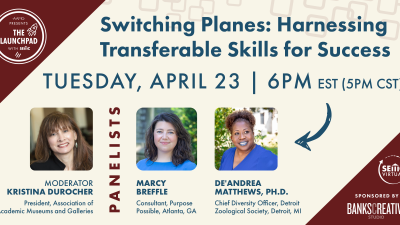
This is the second of a three-part series on sustainable investing. In part one, Anna Raginskaya, Financial Advisor, Blue Rider Group at Morgan Stanley reviewed the concept of sustainable investing and presented several reasons why museums should consider adopting a sustainable investing strategy in their endowments. This post explores some common barriers institutions face as well as best practices for implementation. Stay tuned for part three, in which President and CEO Richard Piacentini will tell us how the Phipps Conservatory and Botanical Gardens has reorganized their investment portfolio to support green and sustainable practices.
Barriers
Despite the tremendous growth in sustainable investing in the last decade, there are a number of common challenges institutions report as impediments to embracing this approach. I explore several of these below.
Misperceptions about performance
Many museum investment committees push back against sustainable investing, citing their fiduciary responsibility to not compromise the endowment’s performance. This concern may stem from the early history of sustainable investing: divestment from certain industries entirely, while politically symbolic, reduces an organization’s investable universe and creates “tracking error” – deviation from the benchmark which may compromise returns.
The industry has evolved far beyond exclusionary investing, with many managers thinking proactively, investing in companies that score well on Environmental, Social or Governance (ESG) metrics. Managers who employ an ESG framework use it as a tool to aggregate capital to best-in-class companies, those that use resources more effectively than their peers, or employ better management practices. As discussed in our previous post, studies have shown there is no trade-off associated with using a sustainable manager: in fact, sustainable managers can mitigate volatility in the portfolio. Investment committees should look at sustainability as an additional layer of financial analysis, one that allows investment managers to identify more efficient companies over the long term and reduce risk. From this perspective, giving adequate consideration to sustainable investing and its potential to enhance returns in the endowment is a true exercise of the committee’s fiduciary responsibility.
A strict reading of mission
Some institutions have very specific missions that encourage the screening out of certain sectors or aligning the portfolio directly to specific values. For example, the mission of the American Museum of Natural History is “to discover, interpret, and disseminate—through scientific research and education—knowledge about human cultures, the natural world, and the universe.” In 2015 the American Museum of Natural History formally requested that all of its investment managers take environmental and climate change issues into account when reviewing and considering investments, decreased indirect holdings of fossil-fuel companies and proactively began seeking investments in renewable energy.
While this shift may seem intuitive for a natural history or science museum, for many museums a strict reading of the mission statement may not present such obvious opportunities for alignment. For art or history museums, it may appear difficult to identify areas of investment that fit strongly with the mission. For these organizations, a broader statement of purpose or values may provide an easier path towards developing a sustainable investing strategy. For example, diversity and education may already be at the heart of the museum’s programs, and other institutional practices may already point to a commitment to environmental sustainability.
Under a broader reading of mission, museums can look to some of the wider themes addressed in programming or faced by the institution and its constituents as starting points for the development of impact priorities. All museums, especially those in coastal settings, will have to consider climate issues and their effect on the museum’s physical spaces. Museums in urban settings may want to consider affordability challenges in their local communities by investing in low-income housing or community infrastructure. Those with active education departments may be interested in exposure to system-wide developments through investments in education technology companies. Impact investing in the creative economy, direct investments in businesses with a focus on art, culture, and design is a growing area of interest. Alternatively, rather than focusing on excluding or including specific sectors, many institutions consider positioning a portion of the portfolio to consider Environmental, Social and Governance metrics broadly, thereby highlighting the systemic connection of the organization to important societal issues without putting a “stake in the ground” on a specific theme.
Board Dynamics
The ongoing conversation about board diversity in gender, race, age and professional background should also take place in museum investment committees. Studies have demonstrated the value of differing opinions in the decision-making process. In the corporate world, diversity not only improves the capabilities of a company board’s decision making and management but has a positive effect on economic metrics such as profitability and value creation, according to a recent study by McKinsey. Interest in sustainable investing is growing generation by generation: surveys show that a majority of millennials are interested in this approach. With increase in the availability of institutional products and more changes in leadership, the appetite for sustainable investing on investment committees is likely to grow.
Practical Considerations for Implementation
If an institution is considering allocating a portion or the entirety of its endowment to sustainable investments, there are a number of key questions that must be asked internally and of the institution’s advisors before moving forward.
Questions to Ask
Museums considering a sustainable investing strategy should consider some key questions before getting started:
- What social and/or environmental challenges does my organization currently help address? Could some of these also be addressed through investments?
- Does it make sense for our organization to develop a mission-aligned Investment Policy Statement?
- Is my current investment advisor equipped to help me learn more about the different approaches to sustainable investing?
Sustainable investing strategies are not one-size-fits-all. The institution’s particular objectives and constraints must be considered, including the museum’s need to draw on the endowment for operations and how the liquidity constraints of certain investments, especially private investments, may pose certain limitations.
Investment Policy Statements
An institution considering sustainable investing should think about how to integrate this desire in the context of their Investment Policy Statement (IPS). A core working group of key stakeholders and decision makers should take inventory of the existing investment policy, as well as the museum’s impact objectives and beliefs. It is important to articulate the institution’s motivations, objectives, and potential constraints for sustainable investing in the IPS – some organizations that implement a sustainable investment strategy consider doing so for a portion or “sleeve” of their endowments to get started – rather than consider the entire endowment at once.
Reviewing peer examples and industry resources to gain familiarity with formats, approaches, and terminology is helpful, as is working with an advisor who understands and has experience in integrating mission into investments.
Due Diligence and Manager Selection
As sustainable investing has become more mainstream, investment products that claim to integrate ESG objectives have proliferated. Due to the variation in investment managers and strategies, expertise in manager selection is critical to determine which investments are driving meaningful positive impact and which are simply “greenwashing,” or marketing themselves as ESG-aware without any real impact.
Institutions, aided by their advisors, must identify a clear due diligence process for any potential investment manager which considers both traditional financial metrics, as well as their approach to sustainability. Investors should look for a documented, defensible and repeatable approach to sustainability, which includes a clear and intentional process for evaluating data and incorporating ESG factors, as well as a process for impact-related outcomes measurement and reporting. Ultimately, the manager must demonstrate strong performance relative to both sustainable and traditional peers and benchmarks.
Investment Advisors
The institution should consider whether their current investment advisor is equipped to execute on the sustainable investment strategy. Expertise varies widely among advisors, and it is important to consider the depth and breadth of capabilities and sustainable investing offerings. An advisor should be able to guide the institution through all aspects of implementing a sustainable investing strategy: from narrowing down on the institution’s individual impact criteria and advising on the IPS, and through due diligence, manager selection and ongoing monitoring.
Conclusion:
With increased scrutiny on museum practices, it is important that boards of trustees have a full grasp of the impacts of the museum’s investment portfolio. Aligning the museum’s portfolio with its broader values not only makes the institution more effective at implementing its mission – but can also help the institution better meet the long-term financial goals of its endowment.
Information contained herein has been obtained from sources considered to be reliable, but we do not guarantee their accuracy or completeness. Investing in the market entails the risk of market volatility. The value of all types of investments may increase or decrease over varying time periods. The returns on a portfolio consisting primarily of sustainable or impact investments may be lower or higher than a portfolio that is more diversified or where decisions are based solely on investment considerations. Because sustainability and impact criteria exclude some investments, investors may not be able to take advantage of the same opportunities or market trends as investors that do not use such criteria.
Anna Raginskaya is a Financial Advisor with the Blue Rider Group at Morgan Stanley, a part of the Global Wealth Management Division of Morgan Stanley in New York. The information contained in this article is not a solicitation to purchase or sell investments. Any information presented is general in nature and not intended to provide individually tailored investment advice. The strategies and/or investments referenced may not be suitable for all investors as the appropriateness of a particular investment or strategy will depend on an investor’s individual circumstances and objectives. Investing involves risks and there is always the potential of losing money when you invest. The views expressed herein are those of the author and may not necessarily reflect the views of Morgan Stanley Smith Barney LLC, Member SIPC, or its affiliates.
Skip over related stories to continue reading article








Comments